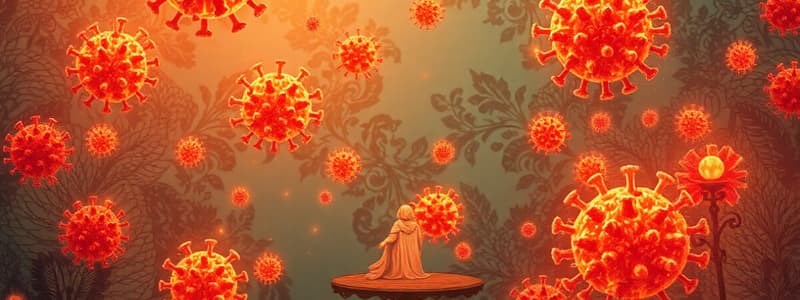Podcast
Questions and Answers
Which of the following best describes atopic dermatitis?
Which of the following best describes atopic dermatitis?
- An IgE-mediated reaction causing skin hives
- A viral infection affecting the respiratory system
- A localized hypersensitivity reaction often associated with eczema (correct)
- A life-threatening systemic condition
What is the primary clinical manifestation of systemic anaphylaxis?
What is the primary clinical manifestation of systemic anaphylaxis?
- A chronic skin condition requiring long-term management
- Skin redness and mild swelling
- Respiratory distress and possible shock (correct)
- Localized itching and irritation
In type 1 hypersensitivity reactions, what is a common trigger for food allergies?
In type 1 hypersensitivity reactions, what is a common trigger for food allergies?
- Genetic predisposition to respiratory illnesses
- Consumption of specific allergenic foods (correct)
- Bacterial infections leading to inflammation
- Pollen exposure during spring
What genetic factor is often associated with an increased risk of hypersensitivity reactions?
What genetic factor is often associated with an increased risk of hypersensitivity reactions?
What role does histamine play in allergic reactions?
What role does histamine play in allergic reactions?
What type of hypersensitivity reaction is associated with hay fever?
What type of hypersensitivity reaction is associated with hay fever?
Which of the following symptoms is NOT commonly associated with hay fever?
Which of the following symptoms is NOT commonly associated with hay fever?
What primarily triggers the symptoms of atopic asthma?
What primarily triggers the symptoms of atopic asthma?
What is a hallmark feature of atopic asthma?
What is a hallmark feature of atopic asthma?
Which immune cells are primarily involved in the tissue injury seen in atopic asthma?
Which immune cells are primarily involved in the tissue injury seen in atopic asthma?
What physical change occurs in the airways of asthmatic patients?
What physical change occurs in the airways of asthmatic patients?
Which of the following conditions is commonly associated with the release of histamine?
Which of the following conditions is commonly associated with the release of histamine?
Atopic urticaria, commonly referred to as hives, is primarily caused by which immune response?
Atopic urticaria, commonly referred to as hives, is primarily caused by which immune response?
What do eosinophils release that contributes to tissue injury in asthma?
What do eosinophils release that contributes to tissue injury in asthma?
What percentage of individuals in developed countries is believed to suffer from allergic rhinitis or hay fever?
What percentage of individuals in developed countries is believed to suffer from allergic rhinitis or hay fever?
What defines hypersensitivity in the context of immune responses?
What defines hypersensitivity in the context of immune responses?
In which stage of hypersensitivity does sensitization occur?
In which stage of hypersensitivity does sensitization occur?
Which type of hypersensitivity is primarily mediated by IgE antibodies?
Which type of hypersensitivity is primarily mediated by IgE antibodies?
What cytokines are produced by allergen-specific Th2 effector cells during the sensitization stage of Type 1 hypersensitivity?
What cytokines are produced by allergen-specific Th2 effector cells during the sensitization stage of Type 1 hypersensitivity?
What differentiates immediate hypersensitivity from delayed-type hypersensitivity?
What differentiates immediate hypersensitivity from delayed-type hypersensitivity?
What is the primary action that occurs during the early phase reaction of Type 1 hypersensitivity?
What is the primary action that occurs during the early phase reaction of Type 1 hypersensitivity?
Which classification of hypersensitivity is associated with autoimmune diseases due to direct antibody action?
Which classification of hypersensitivity is associated with autoimmune diseases due to direct antibody action?
Which cells are specifically coated with allergen-specific IgE during the sensitization stage of Type 1 hypersensitivity?
Which cells are specifically coated with allergen-specific IgE during the sensitization stage of Type 1 hypersensitivity?
What role do cytokines like TNF, IL-1, and IL-6 play in the later stage of Type 1 hypersensitivity?
What role do cytokines like TNF, IL-1, and IL-6 play in the later stage of Type 1 hypersensitivity?
How does mast cell degranulation typically manifest in response to Type 1 hypersensitivity reactions?
How does mast cell degranulation typically manifest in response to Type 1 hypersensitivity reactions?
What distinguishes type 1 hypersensitivity reactions from other types?
What distinguishes type 1 hypersensitivity reactions from other types?
Which of the following best describes an immediate hypersensitivity reaction?
Which of the following best describes an immediate hypersensitivity reaction?
The allergens that primarily trigger type 1 hypersensitivity are typically characterized by what features?
The allergens that primarily trigger type 1 hypersensitivity are typically characterized by what features?
What type of allergic reaction is represented by anaphylaxis?
What type of allergic reaction is represented by anaphylaxis?
What is the relationship between atopy and the immune response to allergens?
What is the relationship between atopy and the immune response to allergens?
What may contribute to the epidemic increase of allergic responses in the Western world?
What may contribute to the epidemic increase of allergic responses in the Western world?
Which classification of hypersensitivity primarily involves immune complex-mediated damage?
Which classification of hypersensitivity primarily involves immune complex-mediated damage?
Which stage of hypersensitivity involves the primary immune response to an antigen?
Which stage of hypersensitivity involves the primary immune response to an antigen?
What is a key characteristic that differentiates delayed-type hypersensitivity from immediate hypersensitivity?
What is a key characteristic that differentiates delayed-type hypersensitivity from immediate hypersensitivity?
Which type of hypersensitivity is primarily associated with cell-mediated immune responses?
Which type of hypersensitivity is primarily associated with cell-mediated immune responses?
What is the primary difference between systemic and local atopic reactions in type 1 hypersensitivity?
What is the primary difference between systemic and local atopic reactions in type 1 hypersensitivity?
Which characteristic of allergens is most relevant for triggering type 1 hypersensitivity reactions?
Which characteristic of allergens is most relevant for triggering type 1 hypersensitivity reactions?
What factor remains unclear regarding the IgE antibody response in individuals with allergies?
What factor remains unclear regarding the IgE antibody response in individuals with allergies?
How quickly do type 1 hypersensitivity reactions generally manifest after exposure to an allergen?
How quickly do type 1 hypersensitivity reactions generally manifest after exposure to an allergen?
Which term is synonymous with the concept of having a hereditary predisposition to type 1 hypersensitivity?
Which term is synonymous with the concept of having a hereditary predisposition to type 1 hypersensitivity?
What effect does histamine have on smooth muscle cells during the early phase reaction of type 1 hypersensitivity?
What effect does histamine have on smooth muscle cells during the early phase reaction of type 1 hypersensitivity?
Which of the following best describes the role of eosinophils in the late phase reaction of type 1 hypersensitivity?
Which of the following best describes the role of eosinophils in the late phase reaction of type 1 hypersensitivity?
How does the route of allergen entry affect the manifestations of type 1 hypersensitivity reactions?
How does the route of allergen entry affect the manifestations of type 1 hypersensitivity reactions?
What is a characteristic consequence of histamine action on sensory nerves during an allergic reaction?
What is a characteristic consequence of histamine action on sensory nerves during an allergic reaction?
What determines the clinical manifestation of localized hypersensitivity reactions like hay fever?
What determines the clinical manifestation of localized hypersensitivity reactions like hay fever?
Flashcards
Type I Hypersensitivity (HS) Early Phase Reaction
Type I Hypersensitivity (HS) Early Phase Reaction
Occurs immediately after allergen exposure, characterized by vasodilation and increased vascular permeability due to histamine and PAF action.
Histamine
Histamine
A key mediator of the early phase of Type I HS, causing vasodilation and increased vascular permeability.
Late Phase Reaction of Type I HS
Late Phase Reaction of Type I HS
Occurs 4-6 hours after the initial reaction, involving the migration of leukocytes (like eosinophils) to the site of allergen exposure and their activation.
Systemic Atopy (Anaphylaxis)
Systemic Atopy (Anaphylaxis)
Signup and view all the flashcards
Localized Hypersensitivity Reactions (Atopy)
Localized Hypersensitivity Reactions (Atopy)
Signup and view all the flashcards
Hay Fever Symptoms
Hay Fever Symptoms
Signup and view all the flashcards
Allergic Rhinitis
Allergic Rhinitis
Signup and view all the flashcards
Atopic Asthma
Atopic Asthma
Signup and view all the flashcards
Asthma Triggers
Asthma Triggers
Signup and view all the flashcards
Bronchoconstriction
Bronchoconstriction
Signup and view all the flashcards
Airway Hyper-responsiveness
Airway Hyper-responsiveness
Signup and view all the flashcards
Atopic Urticaria
Atopic Urticaria
Signup and view all the flashcards
Mast Cells
Mast Cells
Signup and view all the flashcards
Type 1 Hypersensitivity Reaction
Type 1 Hypersensitivity Reaction
Signup and view all the flashcards
Immune Hypersensitivity
Immune Hypersensitivity
Signup and view all the flashcards
Type 1 Hypersensitivity
Type 1 Hypersensitivity
Signup and view all the flashcards
Atopy
Atopy
Signup and view all the flashcards
Anaphylaxis
Anaphylaxis
Signup and view all the flashcards
Delayed-Type Hypersensitivity (DTH)
Delayed-Type Hypersensitivity (DTH)
Signup and view all the flashcards
Allergen
Allergen
Signup and view all the flashcards
Atopic Dermatitis
Atopic Dermatitis
Signup and view all the flashcards
Type 1 HS Sensitization
Type 1 HS Sensitization
Signup and view all the flashcards
Type 1 HS Effector Phase
Type 1 HS Effector Phase
Signup and view all the flashcards
Early Phase Reaction
Early Phase Reaction
Signup and view all the flashcards
Late Phase Reaction
Late Phase Reaction
Signup and view all the flashcards
Mast Cell Degranulation
Mast Cell Degranulation
Signup and view all the flashcards
Hypersensitivity
Hypersensitivity
Signup and view all the flashcards
Type 1 Hypersensitivity (Allergy)
Type 1 Hypersensitivity (Allergy)
Signup and view all the flashcards
What is IgE?
What is IgE?
Signup and view all the flashcards
What is an allergen?
What is an allergen?
Signup and view all the flashcards
What is anaphylaxis?
What is anaphylaxis?
Signup and view all the flashcards
What are mast cells?
What are mast cells?
Signup and view all the flashcards
What's the difference between local and systemic atopy?
What's the difference between local and systemic atopy?
Signup and view all the flashcards
What is the primary mediator of the early phase reaction of Type I HS?
What is the primary mediator of the early phase reaction of Type I HS?
Signup and view all the flashcards
What are the effects of histamine and PAF on blood vessels?
What are the effects of histamine and PAF on blood vessels?
Signup and view all the flashcards
What are the key differences between the early and late phase reactions in Type I HS?
What are the key differences between the early and late phase reactions in Type I HS?
Signup and view all the flashcards
What are the clinical manifestations of Type I HS?
What are the clinical manifestations of Type I HS?
Signup and view all the flashcards
Study Notes
Immune Hypersensitivity
- Immune responses are usually helpful, protecting against pathogens
- Secondary responses to pathogens are often very effective, preventing disease
- In some cases, a primary response is followed by a secondary response harmful to the individual, termed immune hypersensitivity
- Allergic/hypersensitivity responses are not always increased responses to antigens, but rather inappropriate immune responses causing tissue damage and potential disease or death
- Allergic responses are increasing globally and becoming more common
Types of Hypersensitivity Reactions
- Immunologists classify hypersensitivity reactions into four types based on underlying mechanisms
- Type 1: IgE-mediated hypersensitivity/Allergy
- Type 2: Direct antibody-mediated cytotoxic hypersensitivity
- Type 3: Immune complex-mediated hypersensitivity
- Type 4: Delayed-type hypersensitivity (DTH)/Cell-mediated Allergy
Hypersensitivity Reactions (HS) Stages
- All hypersensitivity reactions have two stages
- Sensitization stage: The initial immune response to an antigen
- Effector stage: A secondary immune response
- Hypersensitivity is defined as an excessive or abnormal secondary immune response to an antigen
Humoral & Delayed Hypersensitivity
- Hypersensitivity reactions can occur during humoral or cell-mediated immune responses
- Antibody-mediated or antigen-antibody complex-mediated responses are termed immediate hypersensitivity (HS)
- Symptoms of immediate hypersensitivity appear very quickly (minutes or hours) after antigen encounter
- Humoral hypersensitivity encompasses Type 1, Type 2, and Type 3 hypersensitivities
- Delayed-type hypersensitivity (DTH) is a cell-mediated response, characterized by delayed symptoms that appear days after sensitization
Overview of Four Types of Hypersensitivities
- Complex interplay between humoral and cell-mediated immune responses often blur the categories of hypersensitivity types in clinical settings
Table 18-1: Types of Hypersensitivity (HS) and Their Key Characteristics
- Summary table outlining characteristics of different hypersensitivity types
- Type and common name
- Primary immune system mediator
- Time to symptoms
- Mechanism
- Examples
Allergy: IgE-mediated (Type 1) hypersensitivity (HS)
- "Allergy" and "Type I hypersensitivity" are frequently used interchangeably.
- Allergies are a widespread issue, affecting approximately half of the US population
- Allergies occur in individuals producing IgE antibodies (Abs) against commonplace environmental antigens (allergens)
- Allergens include pollen, hay fever, asthma, atopic dermatitis, and food allergies
- Allergens are non-parasitic antigens, able to stimulate type 1 HS responses upon repeated exposure
- Allergic reactions exhibit the characteristics of a classic humoral response
Examples of Common Allergens
- Displaying an overview of common allergens organized by categories (pollens, foods, drugs, insect products, mold spores, animal hair/dander, latex, foreign serum, and vaccines)
Type 1 Hypersensitivity Continued
- Most allergens are small, soluble, glycosylated proteins or protein-bound substances with molecular weights between 15-40 kDa
- Most individuals successfully clear allergens without symptoms
- However, in some individuals, IgE responses to allergens trigger reactions ranging from mild (itching, swelling) to severe (respiratory difficulties, shock, or death).
- Type 1 HS reactions are characterized by rapid responses (within 30 minutes) subsequent to allergen encounter
- "Atopy" refers to genetic predisposition to developing immediate hypersensitivities against common environmental antigens
- Systemic responses are classified as anaphylaxis; localized responses exhibit tissue-specific symptoms (e.g., hay fever, asthma, hives)
Mechanisms Underlying Type 1 HS
- Two stages to type 1 hypersensitivity reactions: sensitization and effector stages
- Sensitization stage
- Allergen-specific Th2 cells release cytokines (IL-4, IL-5, and IL-13) that encourage B cells to convert to IgE-producing plasma cells, generating allergen-specific IgE.
- IgE antibodies attach to mast cells and basophils' Fc receptors, sensitizing these cells.
- Fc receptors on mast cells and basophils are crucial for sensitization
- Effector phase occurs upon re-exposure to allergen
- Upon second exposure to allergen, antibodies on mast cells and basophils aggregate. This triggers degranulation, releasing pre-formed mediators and newly generated mediators
Sensitization Stage of Type 1 HS
- Mast cells and basophils coated with allergen-specific IgE act as
bombswaiting for allergen re-exposure. - Sensitization ensures that cells are prepared to respond swiftly.
Effector Phase of Type 1 HS
- Triggered by allergen interaction with IgE on sensitized mast cells and basophils
- The effector phase has early and late phase reactions
Early Phase Reaction of Type 1 HS
- Primarily degranulation (release of granule contents) from sensitized mast cells in target tissues
- Symptoms depend on mast cell location and mediator effects
- Mast cells are abundant in skin, connective tissue and mucous membranes
- Symptoms such as coughing, sneezing, tearing of eyes, skin scratching, gut cramping, and diarrhea may occur
- Mediators are pre-formed and stored in mast cell granules
- Symptoms are sustained by newly generated mediators, including cytokines (e.g., TNF-α, IL-1, IL-6), chemokines
- By-products of mast cell destruction can also function as inflammatory mediators
Mediators of the Early Phase Reaction of Type 1 HS
- Table listing major mediators and their cellular sources, noting the types of responses they induce
- Histamine
- Serotonin
- Chemotactic factors
- Proteases
- Cytokines and growth factors
- Platelet activating factors (PAF)
- Leukotrienes
- Prostaglandins
- Major basic Protein
Late Phase Reaction of Type 1 HS
- Occurs 4-6 hours after the initial reaction
- Characterized by the migration of leukocytes (e.g. Th2 cells, eosinophils, basophils, macrophages) to allergen-affected tissues and subsequent activation to carry out their effector functions
- Eosinophils play a notable role in asthma symptoms; airway epithelium is sensitive to harmful proteins released from activated eosinophils
Examples of Type 1 HS reactions
- Types
- Systemic atopy, anaphylaxis
- Localized hypersensitivity reactions (atopy)
- Hay fever
- Atopic asthma
- Atopic dermatitis (eczema)
- Atopic urticaria (hives)
Treatment for Type 1 Hypersensitivity
- Hyposensitization (Immunotherapy): Repeated injections of escalating allergen doses to induce IgG responses
- Medications:
- Antihistamines (e.g., diphenhydramine, loratadine)
- Leukotriene antagonists (e.g., montelukast
- Corticosteroids (for severe asthma)
- Monoclonal anti-IgE antibodies (e.g., Omalizumab): To reduce or block IgE-mediated effects.
Genetic Basis for Type 1 Hypersensitivity
- Genetic susceptibility to atopic responses is strongly associated with multiple genes
- Many atopy-associated genes encode proteins involved in innate immune responses, cytokine production, and MHC proteins
- Th1 cells (producing IFN-γ) limit Type 1 hypersensitivity responses, whereas Th2 cells (producing IL-4, IL-5, IL-13) enhance them
- Downregulation of IL-4 production is potentially a treatment for allergic individuals
Diagnosis of Type 1 Hypersensitivity
- Often assessed via skin testing involving introducing small amounts of potential allergens
- Positive reaction shows wheal and flare response (redness and swelling) within 30 minutes of injection
The Hygiene Hypothesis
- The dramatic rise in asthma incidence is associated with improved sanitation in developed countries
- Studies have shown that individuals exposed to farm environments have a lower incidence of allergic conditions.
- The hypothesis suggests that exposure to various pathogens in early infancy influences immune systems
- This modulation of the immune system can affect their subsequent response to allergens
Next Lecture
- Information about a subsequent lecture topic which is related to the immune hypersensitivity
Studying That Suits You
Use AI to generate personalized quizzes and flashcards to suit your learning preferences.
Related Documents
Description
Explore the mechanisms and types of immune hypersensitivity reactions in this informative quiz. Learn about the four classifications of hypersensitivity and their impacts on human health. Test your understanding of the immune responses that can lead to allergic reactions and tissue damage.




